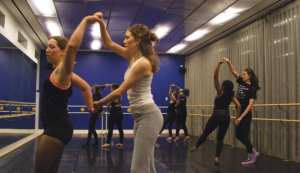
Almost exactly 400 years ago, in 1619, the first enslaved African people arrived in the Chesapeake colonies of the North American coast.
Seventy years ago, hundreds of thousands of black families left the South only to find mistreatment in urban population centers.
Five months ago, 800,000 immigrants lost their protected status as DACA recipients and now live in uncertainty of their place in the world.
The Black Movements Dance Theatre, founded in 1982 by a group of black women determined to make their voices heard, channels these experiences of diaspora and migration in their latest show “Exodus.”
In an interview with The Hoya, BMDT co-directors Kathryn Threatt (SFS ’18) and Ashley Newman (COL ’18) revealed how they want their dancers to connect with the choreography.
Threatt, a native of Virginia, recalled beginning to plan the show in the aftermath of last summer’s white nationalist rally in Charlottesville, Va. For her, the themes of the show weave in and out of her family history and continue to make themselves present every day.
Both Threatt and Newman said they aim to tell the stories of people who find themselves without a home and of the strife that follows these traumatic reminders of not belonging.
Newman wants audience members, no matter their background, to see themselves in the show. “It can even be something as simple as having to come out of your shell,” Newman said.
The definition of an “exodus” becomes malleable and alive, and it rests on the interpretation of the dancers and the audience together. The show seeks to collaborate and interact with its audience in a way that is difficult for a piece of art hanging on a wall: These dancers and their stories are living and dare you to recognize them.
After a fast-paced dance exuding energy and vitality, Newman told the room that “even though this piece is fun, it isn’t necessarily happy.”
The track for the dance, “Gardens of Eden” by Black Coffee, provides a hint to what Newman means: The experience of dislocation produces a painful mix of emotions to process.
The constant movement takes on an almost-chaotic tone as the performers rush past each other across the stage. As the dancers sprint around the room, beating their fists on the ground and leaping high into the air, the pieces’ physicality is apparent.
While this raw energy represents the panic and anxiety stemming from displacement, it also allows the dancers to exercise power over their bodies. As they throw themselves into the choreography, they are able to tell their own stories, letting their bodies be witness to what an exodus means to them.
No dance captures the balance between liberation and isolation better than the solo piece choreographed by Torens Johnson, professional dancer and ballet instructor. As a local Baltimore dance teacher and a student of the influential Alvin Ailey American Dance Theater, Johnson’s entire career has centered around using the body to communicate emotion, oppression and resistance.
According to Ballet Nouveau’s website, Johnson challenges his dancers, “This isn’t just my piece. This is your piece. Make it your own.” After each dancer runs through the piece, he pauses and thinks for a moment. As any great dance instructor does, he follows with “Do it again.”
The solo piece features a bench as a prop, and the dancers use it as an extension of their bodies. Even the mere acoustics of their jumps and spins around the bench help fully realize the human body’s capability to make art.
The solo dance shines as one of the moments in which the show’s message complements the technical craft of dance. As the dancers slide below the bench and launch themselves back up, they create an illusion of uncensored movement and emotion that shows the beauty of using the body as a tool and the stage as a canvas.
“Exodus” seeks to do more than look pretty — it wants to reach out and grab the audience with an urgency that matches the desperation of those featured in the stories that inspired the show.
BMDT’s latest performance is an exhilarating show that sees art as an experience instead of a static object. The show challenges its audience to see themselves in someone displaced and oppressed, even if they might seem to live innumerable worlds away.
“Exodus” will be showing in the Gonda Theatre at 8 p.m. Feb. 16-17. Tickets are $10 general admission and $8 for students.



















